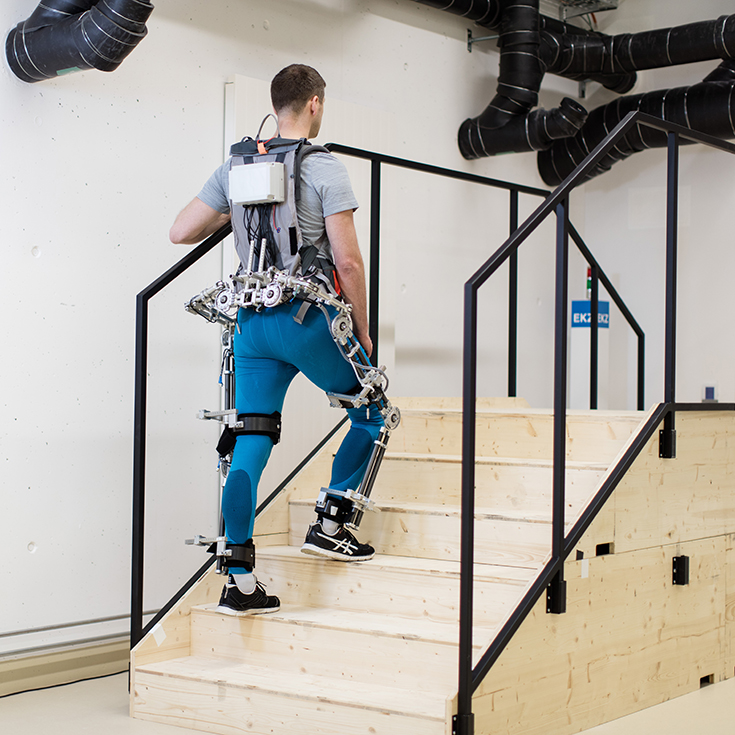VLEXO – Exoskeleton Research Platform
The mobile, passive VLEXO (versatile lower limb exoskeleton) is our current research platform to develop and evaluate new exoskeleton components. It allows for a simple alteration of its kinematic structure (number and kind of DOFs), dynamics and mechanical interfaces to investigate how different configurations affect the user. Aim of the project is to develop and evaluate ergonomic exoskeleton structures that can be used in different future systems.
Designing the underlying mechanical structure of lower limb exoskeletons for assistance and rehabilitation is a demanding task that requires a good understanding of the interaction that takes place between the exoskeleton and the human user wearing it. Often the effects of a given mechanical design on the user are not straightforward or intuitive.
The intention behind the experimental exoskeleton is to provide a system to test and evaluate ideas and aspects of exoskeleton designs and how they affect the user with respect to gait quality and performance. Consequently, the system includes multiple mechanical features, provides the possibility to vary the relevant parameters quickly and independently. The prototype is a passive, instrumented exoskeleton with three DOFs at each hip joint and one DOF at each knee. The load bearing structure is adjustable in length to adapt to different subjects. Up to three cuffs per leg attach the exoskeleton to the human leg and a backpack element is used to interface with the human hip and upper body. Integrated position and force sensors provide measurements of the exoskeleton joint movements and interaction forces with the user. Furthermore, misalignment compensation joints were integrated in all cuff attachments. The movement of each of the 14 joints can either be locked or unlocked to change the kinematic configuration and compare them to each other. The knee joints and the shank segments can be detached so that the hip module can be used separately.
The VLEXO is currently used for two main investigations:
1. To investigate the effect of lower limb exoskeleton joint misalignments: Misalignment between an exoskeleton joint and the corresponding joint of the user can induce undesired interaction forces that can potentially constraint the movements of the user and cause discomfort, pain or even injury. The aim is to investigate under what circumstances misalignment becomes a problem. Additionally, we evaluate a mechanical misalignment compensation mechanism and test if it allows an unconstraint and safe operation even with large joint misalignment.
2. To investigate the effects of the additional masses and kinematic constraints imposed by the exoskeleton: Wearing an exoskeleton can cause constraints; either caused by the additional mass or due to a kinematic mismatch because the exoskeleton does not replicate the human anatomy perfectly. In order to investigate how severely those effects are, we use the VLEXO in different kinematic configurations to evaluate constraining effects it imposes on the human user.

Publications
V. Bartenbach, D. Wyss, D. Seuret and R. Riener. A lower limb exoskeleton research platform to investigate human-robot interaction. In Rehabilitation Robotics (ICORR), 2015 IEEE International Conference on (pp. 600-605). IEEE (2015)
Funding
This work was supported by the Swiss National Science Foundation through the National Centre of Competence in Research on Robotics and the Commission for Technology and Innovation (CTI) of Switzerland.
